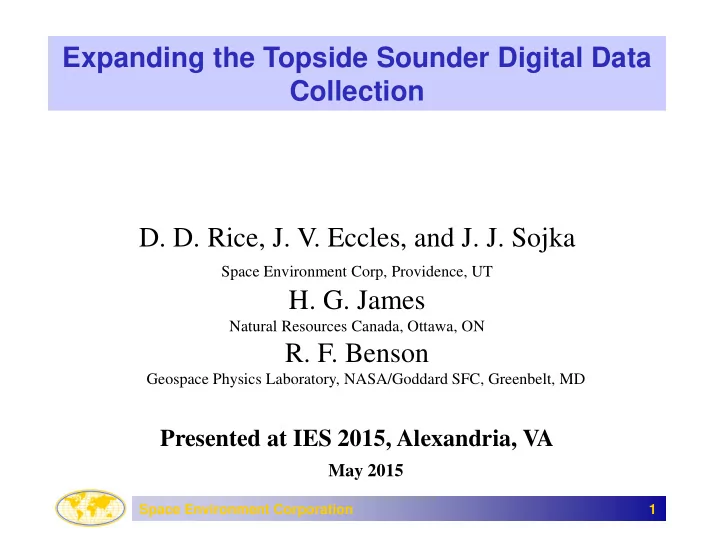

Expanding the Topside Sounder Digital Data Collection D. D. Rice, J. V. Eccles, and J. J. Sojka Space Environment Corp, Providence, UT H. G. James Natural Resources Canada, Ottawa, ON R. F. Benson Geospace Physics Laboratory, NASA/Goddard SFC, Greenbelt, MD Presented at IES 2015, Alexandria, VA May 2015 Space Environment Corporation 1
Overview • The International Satellites for Ionospheric Studies (ISIS) program produced a unique topside sounder data set from 1962 to 1990 • Space Environment Corporation has obtained 35mm film ionograms from the ISIS 2 topside sounder from the early 1970s for passes near Resolute Bay • The ionograms are being scanned and metadata added including coordinate registration, time, and ephemeris information • Film ionograms from the Resolute Bay ionosonde have also been obtained for comparison with the topside profiles • The digital topside data will be added to the online collection created from magnetic tapes by R. F. Benson Space Environment Corporation 2
ISIS-2 Film Ionograms • Satellite data was downlinked to ground stations as analog radio signals • The signals were recorded on magnetic tape • A subset of the magnetic tapes were converted to 35mm film to facilitate study of the topside ionograms • A typical film includes data from about a dozen magnetic tapes, covering a few days • A header frame was generated for each tape to identify the time and state of the satellite instruments Space Environment Corporation 3
ISIS-2 Film Ionograms • A typical topside ionogram begins with a fixed-frequency sounding (1.95 MHz in this case) followed by a sweep of 0.1-10 MHz or 0.1-20 MHz (shown below) • The code at the bottom of the frame identifies the satellite, ground station, and UT date and time of the sounding • White dots above the time code are 1-second markers • The white trace below the dark ionogram traces indicates background broadband noise levels Space Environment Corporation 4
Coordinate Registration: ISIS-2 Film Ionograms • Film ionograms include frequency markers, annotated along the top of the frame, and virtual range markers, annotated on the left side of the frame • The 1668 km marker is a high-precision marker that can be used to check the ordinary 200 km markers • ISIS-2 had a nearly circular orbit (1423x1356 km), with the greater virtual depths seen here due to normal ionospheric retardation • The F topside trace seen here shows spread with a critical frequency of about 5.5 MHz • Plasma resonance spikes are seen between 0.75-2 MHz • The 4-5 MHz gap is due to satellite spin Space Environment Corporation 5
Resolute Bay ISIS-II Pass and Ionosonde • One ISIS-2 pass recorded at Resolute Bay is shown here • The Resolute Bay ionosonde RB974 location is marked • The ground track of the satellite during two topside soundings is shown by red segments • The green outline is the 500 km radius about RB974 • Hourly hand-scaled parameters from the RB974 sounder are available from NGDC SPIDR • The RB974 film has 15-minute cadence ionograms Space Environment Corporation 6
Resolute Bay Ground Based Ionosonde • High-latitude ionograms can be difficult to scale due to absorption events, blanketing from auroral E, and chronic spread-F • In addition, the RB974 transmitter appears to be switched off during many ISIS- 2 passes, possibly to avoid interference with the ground station operation • The example below corresponds to the ISIS-2 pass shown in the previous slides • Sporadic E, an F1 layer, and spread-F can all be seen in this ionogram Space Environment Corporation 7
Topside and Bottomside Profiles • The bottomside ionogram shows a disturbed, spread F2 layer up to the peak • The topside ionogram shows the spread from the F2 peak up to the satellite altitude of about 1400 km • The spread foF2/fxF2 frequency range is about 5.5-6.5 MHz in both views • Science objective is to create full ionospheric EDP, in the polar cap during disturbed periods. Space Environment Corporation 8
Topside and Bottomside Profile Status • ISIS-II films for 8 events acquired, and Resolute Bay ionosonde film. • Films for one event have been digitized. • Coordinate registration prototype operational. • Work to be done; • The SEC ESIR software uses an ensemble approach to provide uncertainties for quantities that are not well-defined, like the E/F valley and moderately-spread traces but this software will not work for topside. • Different inversion methods are needed for topside traces, such as the TOPIST program. • Topside traces have unique artifacts, such as gaps due to the changing antenna orientation caused by satellite spin. Space Environment Corporation 9
Discussion • The utilization and long-term survival of historic data sets archived on film depends on the cost-effective conversion of the films to digital form. We will determine cost-effectiveness. • Data sets spanning decades, such as those from ground-based ionosondes and the ISIS family of topside sounders, are of particular value for identifying long-term trends in the ionosphere. • Our science goal is to reconstruct full EDPs at Resolute Bay during disturbed conditions. Compare with todays ISRs at same location. • The methods developed here will be useful for making the historic topside data set available to the research community in a format that is useful for modeling and analysis. Space Environment Corporation 10
Recommend
More recommend